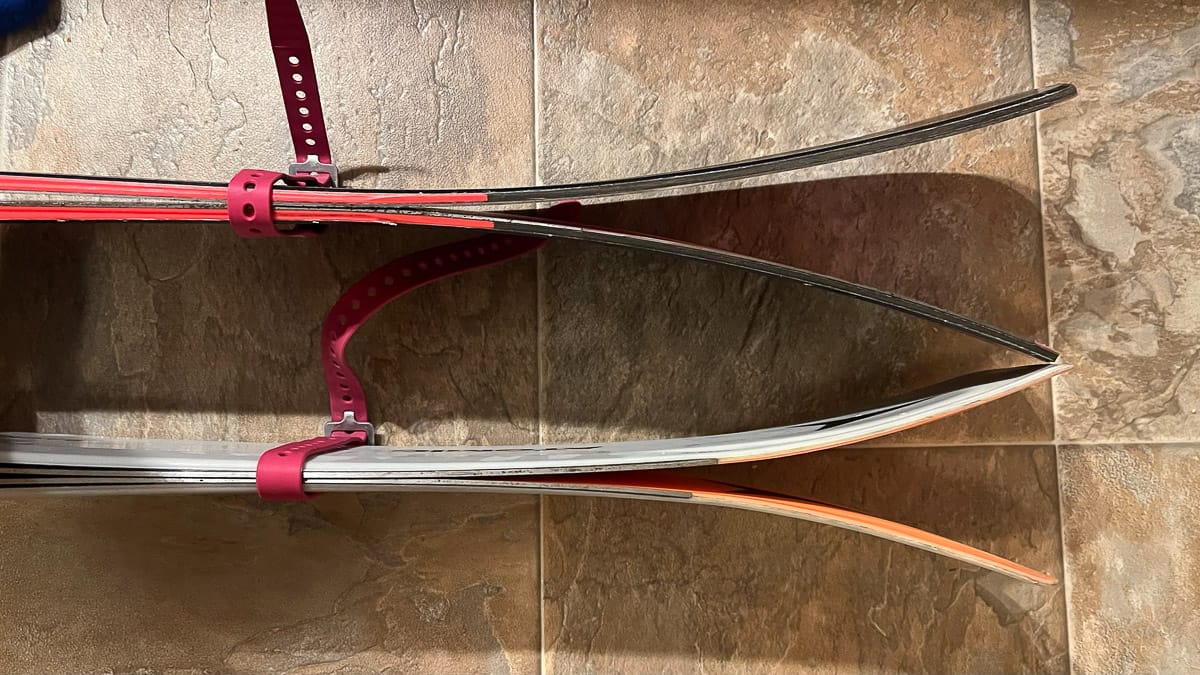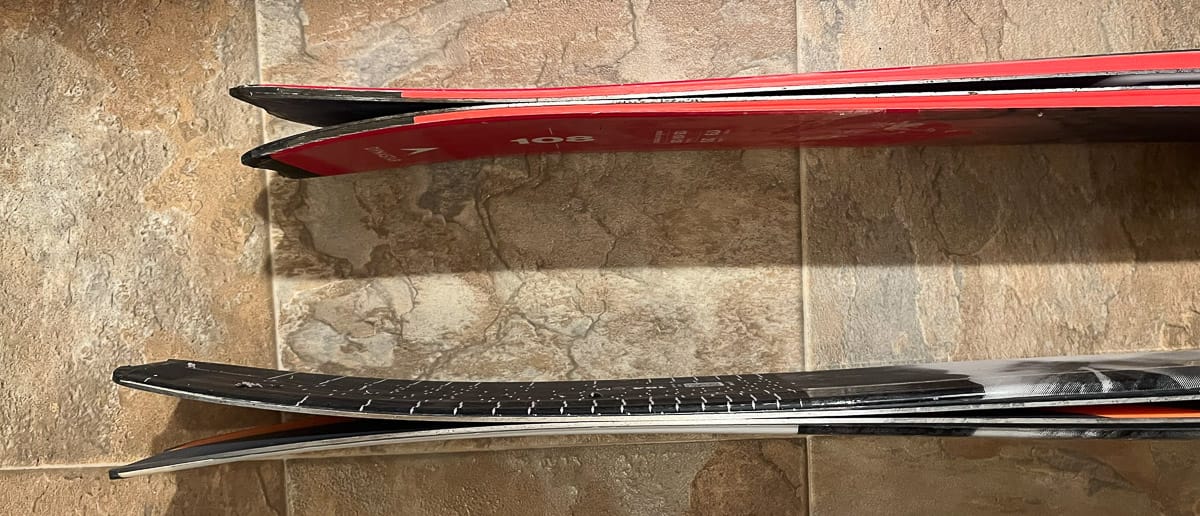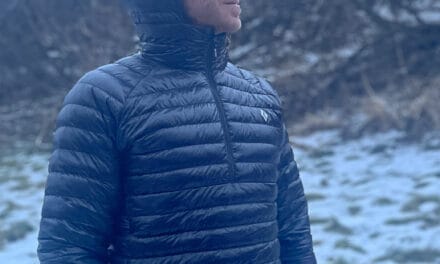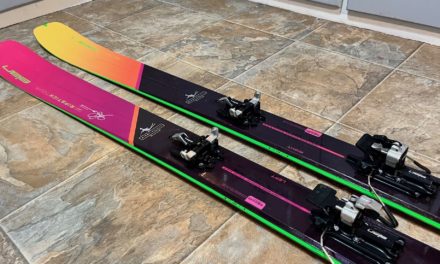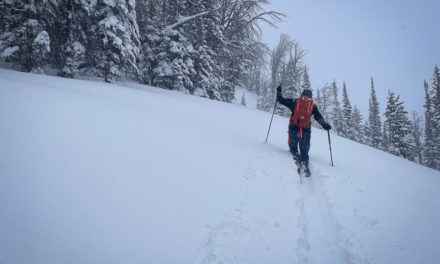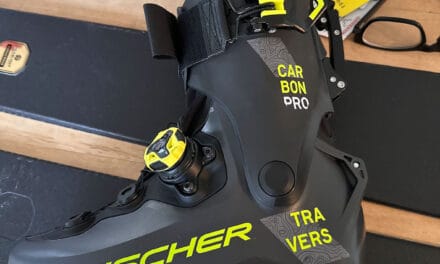With the right boot combo and aggressive skiing, the Dynastar M-Tour 108 F-Team excels in open terrain and good snow.
The original Chamonix ski brand, Dynastar, should need no introduction. I’ve always had a soft spot for Dynastar. The first new skis I ever received were Omniglass kid’s “race” skis. Between that personal connection and a fascination with the French steep skiing scene and the deeply intertwined heritage with the Dynastar brand, there is a certain romance to the Dynastar brand that draws me to their skis on a visceral level, unlike any other brand.
With their traditional roots come some appropriately traditional design elements in their touring skis. The current Dynastar alpine line includes the M-Free and M-Pro series (there are others, but these are the freeride/off-piste skis). The M-Free is a modern, progressive freeride ski with a forward mount point, deep rocker lines, and a loose, surfy characteristic. Meanwhile, the M-Pro series carries on the heritage (at least some of it) of the cult classic Legend Pro Rider skis. I like to refer to the Legend Pro Riders and now M-Pros as trucking skis–built to go straight and fast. The M-Pro is the modern heavyweight inspiration for the ski we are looking at here, the M-Tour 108.
Design Highlights
The M-Tour 108 marks the return of a powder touring ski to the Dynastar lineup after approximately a decade where the widest skis in the touring line were 97/99mm. The Cham High Mountain skis were the last touring skis from the brand in the relatively wide widths of 107 and even 117mm. The trademark wide, tapered shovels and rearward mount points are consistent from the Cham to the Mythic to the M-Tour.
The M-tour 108 sports a unique shape that blends some traditional elements with plentiful taper and tip rocker. The -13cm recommended mount is wildly different from the current norms in lightweight touring skis, which mostly fall in the -6 to -10cm range. Fitting with the rearward mount is a minimally rockered tail that is nearly flat and quite stiff.
10mm of tip-tail taper is on the low side for skis of this width and turn radius—I would say this makes the sidecut feel straighter than the 20 m radius might suggest. Side by side, the shape is generally quite similar to the Atomic Backland 109 I am testing this winter. The shovels have a similar deep taper, long aggressive rocker (which is more abrupt/splayed on the Dynastar), and strong camber underfoot. The Atomic tail is much more rockered and a bit more splayed, and the Atomic has a bit more tip-tail taper. However, on the Dynastars, the narrowest point and mount point are significantly set back. This makes for a fascinating case study of how important mount point is for ski feel and character. The Atomic is loose and playful, easygoing, and easy to recommend to just about anyone. The M-Tour 108, meanwhile, is an unforgiving directional charger—it rewards a forward stance, likely requires a beefier boot, and is a punishing handful when driven from a neutral or backseat stance. A friend reported “good snow for good skiers” in a wind-buffed Teton run the other day. In the same vein, I would characterize the M-Tour as a good ski for good skiers.
A full sidewall and Hybrid Poplar/PU core give the M-Tour some backbone and solid torsional rigidity that keep the M-Tour in charging territory rather than leaning into its resemblance to a big, tapered ski-noodle/DPS. The PU core component is reminiscent of DPS’s poured PU sidewall tech and likely adds some good damping characteristics that aren’t often present in similarly light/stiff skis.
The M-Tour is pretty svelte for its size. It does seem to sacrifice in the durability department. Top sheet chips are a normalexpectation skiing in rocky and low tide areas, but the M-Tour has developed many chips and a few good core shots that show off a surprisingly thin p-tex base. I could go for an extra 100g for a thicker base and more durable topsheet material.
Testing Setup
Whew, finding a testing setup to make the M-Tour work for me was a bit of an adventure. I started with a Dynafit Rotation demo binding (which has less ramp than a non-demo Rotation but still more ramp than I am used to) mounted at the recommended line. I was mostly skiing the Technica Zero G Peak at the time I received the skis. This combo did not work for me—I felt like a beginner skier getting bucked around in the backseat most of the time (I’m usually at least a little better than this).
Fast forward a few months, and I bit the bullet and swapped the bindings for a Ski Trab Gara Titan (with adjustment plate for a +4mm ramp), and really upped my directional skiing game this fall by acquiring the Scarpa 4Quattro Pro boots. With a close-to-flat ramp angle, 19 degrees of forward lean, and a progressive forward flex, I was as set up for success as I could have been to enjoy the M-Tour, and enjoy it I did.
In a recent Gear Shed podcast we talked about boot-ski pairing; I mentioned that my approach often involves heavier and more progressive skis paired with lighter and less progressive/supportive boots to achieve a relatively pleasant touring experience with maximal touring fun. The M-Tour is a different beast in this regard: a progressive and damp boot that allows one to absorb texture changes or bumps while maintaining forward pressure is critical to full enjoyment here.
Field Testing
Powder/soft snow
Given its place as the widest ski in the Dynastar touring line, powder is the obvious testing ground for the M-Tour 108. A major selling point of the big shovels and rearward mount is the ability to ski deep(ish) powder with an aggressive and forward stance. For anyone coming from skinny, traditional skis that encourage a quad-torching backseat driving technique in deep powder, the ability to lean in and pressure the shovels in powder is a real treat.
The M-Tour was most enjoyable in open terrain where consistent, long arcing turns were possible. I can picture having a blast on a big, open, above-treeline Chamonix classic like the Grand Envers on these skis. On the contrary, in more technical terrain like tighter trees, I had to slow down and be more intentional to feel in control on the M-Tour. Getting a little back seat and shutting down speed into trees felt like a recipe for some ungraceful, slightly out-of-control muscling rather than a graceful tip-initiated pivot or carve.
Crud/tracked/variable snow
Various factors contribute to this ski functioning well in this snow category—remember, good skis for good skiers. When combined with a boot with good suspension, variable snow works pretty darn well. The combination of rocker, taper, and a hint of softness in the tips is about right to handle small inconsistencies gracefully when encountering some level of crud/3D snow or wind effect. The major caveat here is the ability to pressure the tips and stay in the front of your boots; once you get the backseat, all bets are off; they are a handful.
I found breakable surfaces especially challenging on the M-Tour. The combination of a flat tail and rearward mount focuses a lot of pressure on a small area of the tail, and it seems to hook up and dig in more than most. We often give a pass/fail grade on breakable crusts. I’ll go with a fail here.
Firm Snow/Steeps
I’ll admit to a bias for more progressive mount points in steep terrain. Listening to Jason’s interview with Dynastar athlete Vivian Bruchez makes me think that perhaps I am not “giving myself to the slope” sufficiently, which makes it feel like my tails get hung up on the uphill slope in a steep turn. With so much more tip in front of the bindings, a steep turn (hop turn?) feels like a more dramatic motion to get the tips around, rather than the subtle pivot I aspire to.
That said, the shape and rocker profile possess some good attributes for the steeps. The tail is flat, and the radius is long, making for quite a lot of edge contact for a ski with a heavily rockered tip. In more “open it up” style terrain, linking and arcing turns vs. slower one-at-a-time turns, the M-Tour was confident on edge and handled changing conditions reallywell for its weight.
Resort Skiing/groomers/corn
Given its inspiration from the M-Pro 108, the shape of the M-Tour 108 is certainly suited for various forms of resort skiing. The M-Tour is pretty darn fun to lay into on a groomer and is relatively adept in tracked-up resort conditions. All this being said, we are talking about a 108 underfoot, 1530g touring ski…A little wide for dedicated resort uphilling and a little light for lift-served skiing. The fun aspects of laying into a nice arced turn certainly hold true in corn snow, but I found the tails went back to feeling like quite a handful in overcooked or under-frozen spots.
Conclusion
After lusting over these skis from the moment I heard about them, I probably won’t continue to ski them often once this review is published. Given my general taste for loose and progressive skis, it isn’t a huge surprise that I wouldn’t get along great with such a directional ski.
That being said, I enjoyed the process of starting the season on the M-Tour 108 paired with the Scarpa Quattro Pro and attempting to re-learn to ski in a more forward, aggressive body position. Giving myself a blank slate to learn to ski the M-Tourwell was worthwhile and a far better experience than writing them off right away. Although they aren’t my cup of tea, I think the M-Tour 108 is an interesting and worthwhile ski for the right person.
Open terrain, good snow, and aggressive skiing come to mind for places and styles that the M-Tour 108 excels. I picture an ex-ski racer living in Squamish, Girdwood, or the Alps enjoying these as a lightweight daily driver.

Open terrain, good snow, and aggressive skiing come to mind for places and styles that the M-Tour 108 excels.
Specs
Available lengths (cm): 171, 179 (Tested), 187
Weight: 1434g
Dimensions (mm): 135-108-125
Turn radius (m): 20
Core: Poplar/PU
Build Comments: Full sidewall, shaped titanal insert
Shape: Big, tapered shovel, rockered tip, camber underfoot, relatively flat tail, very directional.
Recommended Mount Point (cm from center): -13 (tested at -10.5)
Drill size: 4.1x9mm
Similar Models: Black Crows Corvus Freebird, Rossi Escaper 105 Nano
Price: $799.95




